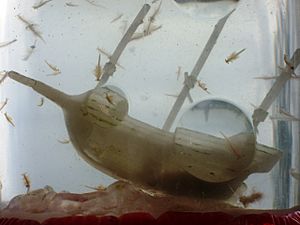Sea-Monkeys facts for kids
 |
|
| Other names | Instant Life |
|---|---|
| Type | Novelty aquarium pet |
| Inventor(s) | Harold von Braunhut |
| Country | United States |
| Availability | 1996–present |
Sea-Monkeys are a special kind of pet you can grow at home. They are actually a type of tiny shrimp called brine shrimp. These amazing creatures can go into a deep sleep, almost like playing dead, which helps them survive. Sea-Monkeys were first created in the United States in 1957 by Harold von Braunhut. You buy them as tiny eggs. You just add the eggs to tap water with some special powders, and they hatch! In the 1960s and 70s, Sea-Monkeys were advertised a lot, especially in comic books. They are still a well-known pet today.
History of Sea-Monkeys
In 1956, special ant farms became very popular. The next year, in 1957, Harold von Braunhut came up with an idea for a new pet. He wanted to sell tiny shrimp that could be brought to life at home.
Von Braunhut worked with a scientist named Dr. Anthony D'Agostino. They created a special mix of nutrients and chemicals. These dry powders could be added to regular tap water. This mix would create a perfect home for the shrimp to live and grow. Von Braunhut received a patent for this invention in 1972.
At first, these pets were called "Instant Life." They sold for 49 cents. But in 1962, von Braunhut changed the name to "Sea-Monkeys." He chose this name because they live in salt water. Also, the way their tails move made them look a bit like monkeys.
Sea-Monkeys were advertised a lot in comic books. This happened throughout the 1960s and early 1970s. The ads showed cartoon pictures of the Sea-Monkeys. These drawings made them look like tiny people, not like real shrimp. Many people who bought them were surprised. The real Sea-Monkeys did not look like the pictures. Also, the pets often did not live very long. Von Braunhut once said, "I think I bought something like 3.2 million pages of comic book advertising a year. It worked beautifully."
How to Use Sea-Monkeys
Starting a Sea-Monkey colony is quite simple. First, you add a packet called "Water Purifier" to a tank of water. This packet contains salt, a water conditioner, and some tiny brine shrimp eggs.
You wait for 24 hours after adding the first packet. Then, you add the contents of a packet called "Instant Life Eggs." This packet has more eggs, plus some food and other helpful things. Soon after, the Sea-Monkeys hatch from the eggs that were in the "Water Purifier" packet.
After they hatch, you add "Growth Food" every few days. This food helps them grow big and strong. The best temperature for the eggs to hatch is about 24 to 27 degrees Celsius (75 to 81 degrees Fahrenheit).
Sea-Monkey Biology
The animals sold as Sea-Monkeys are a special type of brine shrimp. They are said to be a mix of different kinds of Artemia. The company claims they live longer and grow bigger than regular brine shrimp. However, these claims are mostly found in the company's own ads.
Sea-Monkeys have an amazing ability. They can go into a state of "suspended animation." This means they can dry out completely and seem lifeless. But when they are put back in water, they come back to life! This helps them survive in places where water dries up.
Sea-Monkeys have even traveled to space! Astronaut John Glenn took Sea-Monkeys with him on October 29, 1998. They went aboard the Space Shuttle Discovery during mission STS-95. After nine days in space, they came back to Earth. Eight weeks later, they hatched! They seemed fine after their space trip.
However, earlier space experiments had different results. On the Apollo 16 and Apollo 17 missions, Sea-Monkey eggs went to the Moon. They were exposed to strong space radiation. Only about 10% of the eggs that hatched survived to become adult shrimp. Some of the shrimp that did hatch had unusual shapes or problems with their swimming parts or eyes.
See also
 In Spanish: Sea Monkeys para niños
In Spanish: Sea Monkeys para niños



